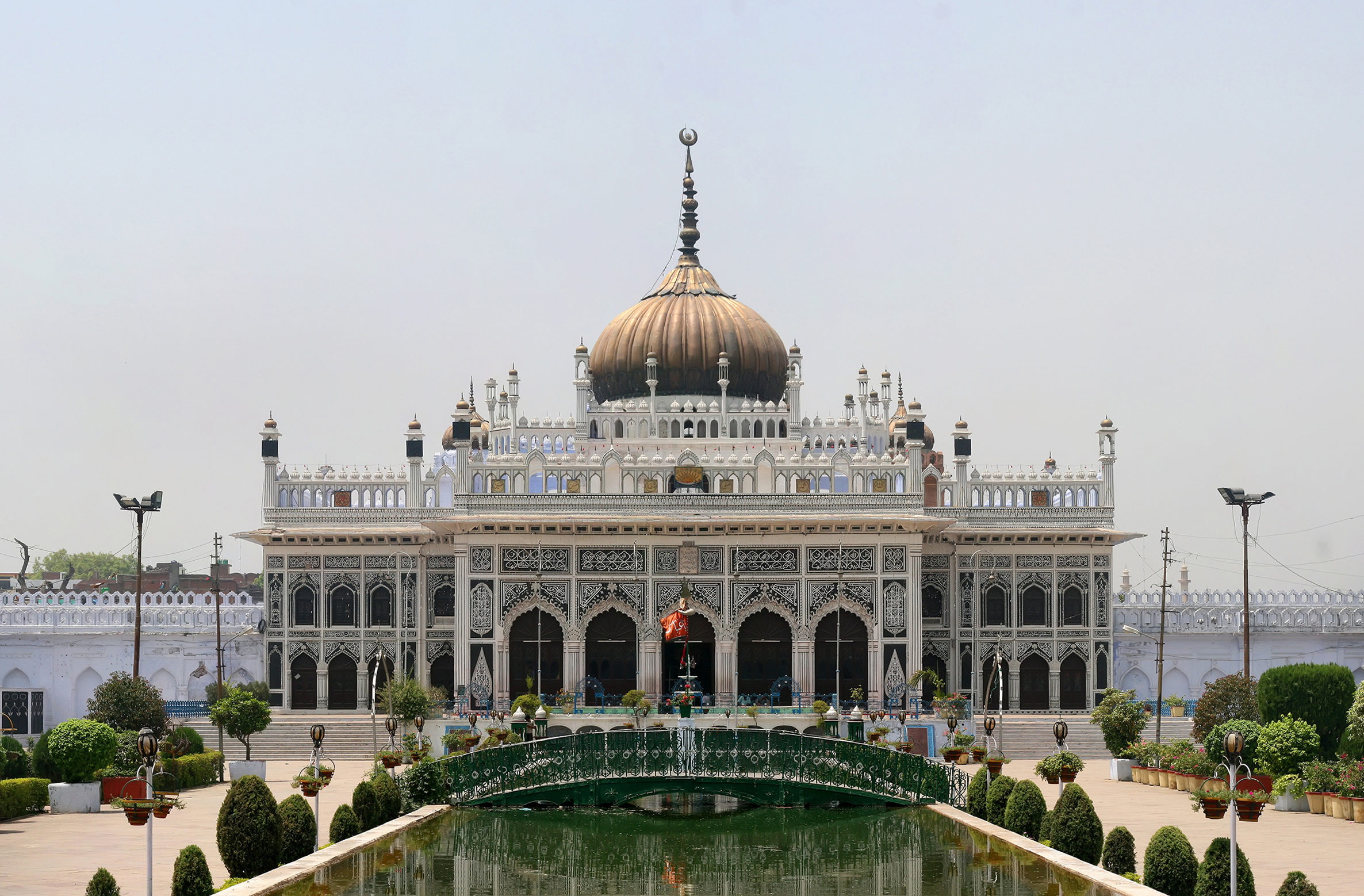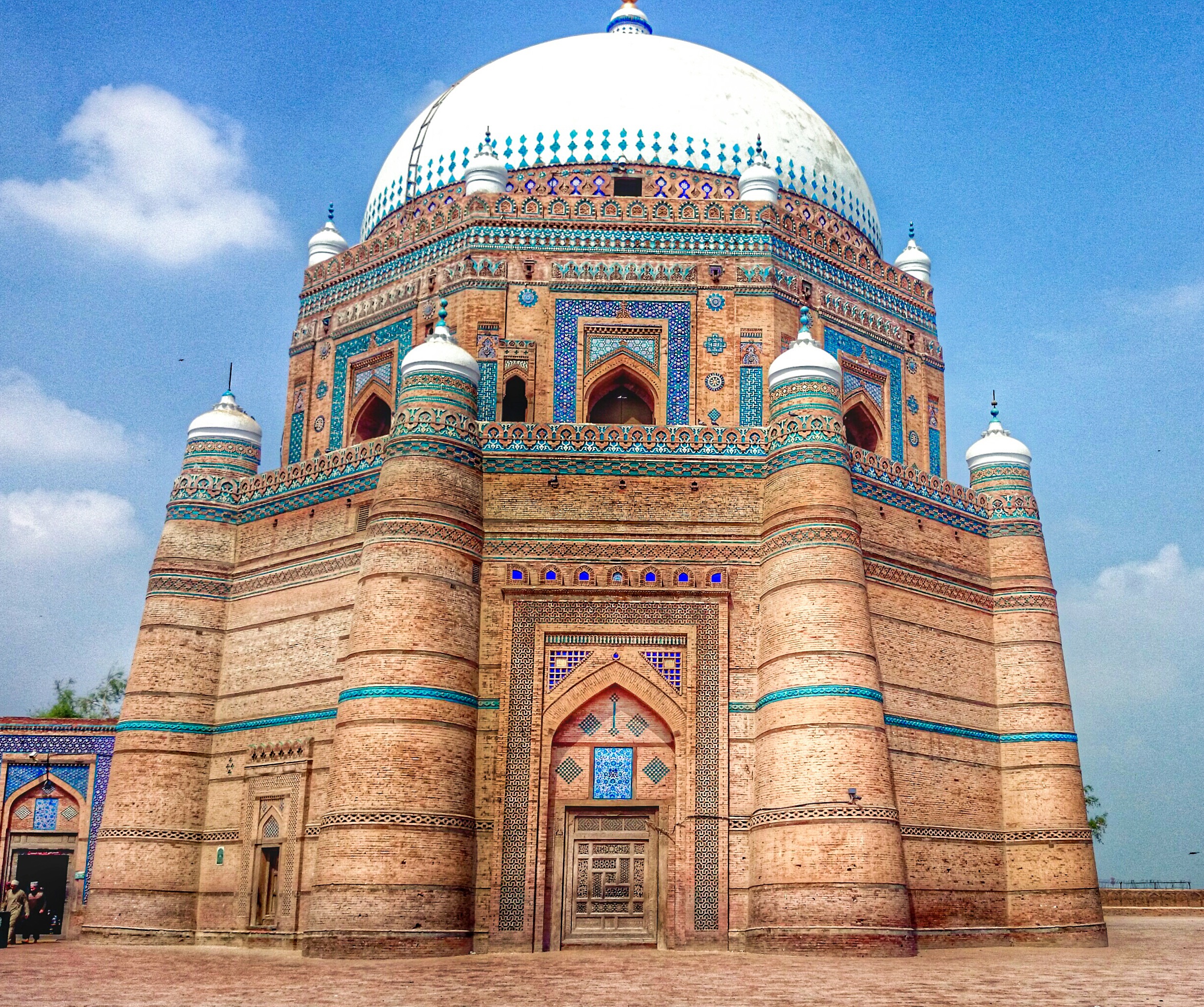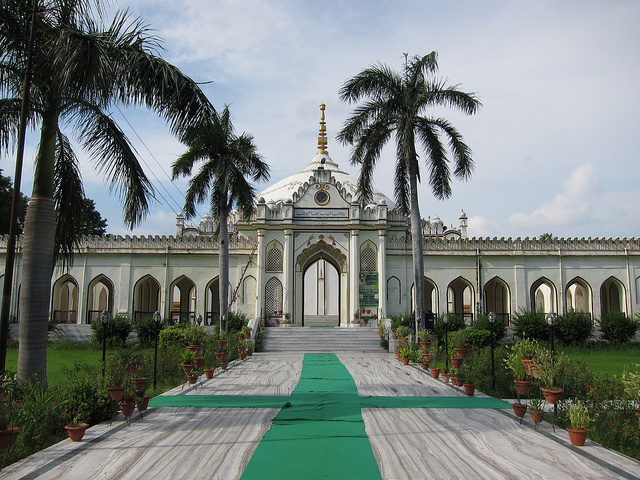|
Roomi Darwaza
The Rumi Darwaza (sometimes known as the Turkish Gate), in Lucknow, Uttar Pradesh, India, is a gateway which was built by Nawab Asaf-Ud-Daula in 1784. It is an example of Awadhi architecture. The Rumi Darwaza is sixty feet tall and was modeled after the Sublime Porte in Istanbul. It is adjacent to the Asafi Imambara, Teele Wali Masjid and used to mark the entrance to Old Lucknow. When the city grew and expanded, it was used as an entrance to a palace which was later demolished by the British Raj following the Indian Rebellion of 1857. Etymology The gate was modelled after a historical gate in Constantinople. Rumi refers to Rûm, the historical name used by the Islamic world to denote the region roughly corresponding to Anatolia, or the dominion of the former Eastern Roman Empire. "Rumi Darwaza" in Hindustani translates to "Turkish Gate" in English. Design The darwaza is distinct from Mughal architecture in terms of style and materials used. The design consists of a big ar ... [...More Info...] [...Related Items...] OR: [Wikipedia] [Google] [Baidu] |
Asaf-Ud-Dowlah
Mirza Asaf-ud-Daula (23 September 1748 – 21 September 1797) was the Nawab wazir of Oudh ratified by Shah Alam II, from 26 January 1775 to 21 September 1797, and the son of Shuja-ud-Dowlah. His mother and grandmother were the Begums of Oudh. Reign Asaf-ud-Dowlah became Nawab at the age of 26, on the death of his father, Shuja-ud-Daula, on 28 January 1775. He assumed the throne with the aid of the British East India Company, outmanoeuvring his younger brother Saadat Ali who led a failed mutiny in the army. British Colonel John Parker defeated the mutineers decisively, securing Asaf-ud-Daula's succession. His first Chief Minister, Mukhtar-ud-Daula, was assassinated in the revolt. The other challenge to Asaf's rule was his mother Umat-ul-Zohra (better known as Bahu Begum), who had amassed considerable control over the treasury and her own ''jagirs'' and private armed forces. She, at one point, sought the Company's direct assistance in the appointment of anti-Asaf ministe ... [...More Info...] [...Related Items...] OR: [Wikipedia] [Google] [Baidu] |
Nawab Asaf-Ud-Daula
Mirza Asaf-ud-Daula (23 September 1748 – 21 September 1797) was the Nawab wazir of Oudh ratified by Shah Alam II, from 26 January 1775 to 21 September 1797, and the son of Shuja-ud-Dowlah. His mother and grandmother were the Begums of Oudh. Reign Asaf-ud-Dowlah became Nawab at the age of 26, on the death of his father, Shuja-ud-Daula, on 28 January 1775. He assumed the throne with the aid of the British East India Company, outmanoeuvring his younger brother Saadat Ali who led a failed mutiny in the army. British Colonel John Parker defeated the mutineers decisively, securing Asaf-ud-Daula's succession. His first Chief Minister, Mukhtar-ud-Daula, was assassinated in the revolt. The other challenge to Asaf's rule was his mother Umat-ul-Zohra (better known as Bahu Begum), who had amassed considerable control over the treasury and her own ''jagirs'' and private armed forces. She, at one point, sought the Company's direct assistance in the appointment of anti-Asaf ministers. ... [...More Info...] [...Related Items...] OR: [Wikipedia] [Google] [Baidu] |
Lucknow
Lucknow () is the List of state and union territory capitals in India, capital and the largest city of the List of state and union territory capitals in India, Indian state of Uttar Pradesh and it is the administrative headquarters of the eponymous Lucknow district, district and Lucknow division, division. Having a population of 2.8 million as per 2011 census, it is the List of cities in India by population, eleventh most populous city and List of million-plus urban agglomerations in India, the twelfth-most populous urban agglomeration of India. Lucknow has always been a Multiculturalism, multicultural city that flourished as a North Indian cultural and artistic hub, and the seat of power of Nawabs in the 18th and 19th centuries. It continues to be an important centre of governance, administration, education, commerce, aerospace, finance, pharmaceuticals, information technology, design, culture, tourism, music, and poetry. Lucknow, along with Agra and Varanasi, is in the Uttar P ... [...More Info...] [...Related Items...] OR: [Wikipedia] [Google] [Baidu] |
Chota Imambara
Chota Imambara, also known as Chhota Imambara, or Imambara Hussainabad Mubarak is a monument located in the city of Lucknow, Uttar Pradesh, India. It took 54 years to build. Built as an imambara, or a congregation hall for Shia Muslims, by Muhammad Ali Shah, the Nawab of Awadh in 1838, it was to serve as a mausoleum for himself and his mother, who is buried beside him. The significance of Panjetan, the holy five, is emphasized with five main doorways. This Imambara consists of two halls and a Shehnasheen (a platform where the Zarih of Imam Husain is kept.) Zarih is the replica of that protective grill or structure which is kept on the grave of Imam Husain at Karbala, Iraq. The large green and white bordered hall of Azakhana is richly decorated with chandeliers and a good number of crystal glass lamp-stands. In fact, it was for this profuse decoration that the Imambara was referred by European visitors and writers as The Palace of Lights. The exterior is very beautifu ... [...More Info...] [...Related Items...] OR: [Wikipedia] [Google] [Baidu] |
Tourist Attractions In Lucknow
Tourism is travel for pleasure, and the Commerce, commercial activity of providing and supporting such travel. World Tourism Organization, UN Tourism defines tourism more generally, in terms which go "beyond the common perception of tourism as being limited to holiday activity only", as people "travelling to and staying in places outside their usual environment for not more than one consecutive year for leisure and not less than 24 hours, business and other purposes". Tourism can be Domestic tourism, domestic (within the traveller's own country) or International tourism, international. International tourism has both incoming and outgoing implications on a country's balance of payments. Between the second half of 2008 and the end of 2009, tourism numbers declined due to a severe Economy, economic slowdown (see Great Recession) and the outbreak of the 2009 2009 flu pandemic, H1N1 influenza virus. These numbers, however, recovered until the COVID-19 pandemic put an abrupt end to th ... [...More Info...] [...Related Items...] OR: [Wikipedia] [Google] [Baidu] |
Indo-Islamic Architecture
Indo-Islamic architecture is the architecture of the Indian subcontinent produced by and for Islamic patrons and purposes. Despite an initial Arab presence in Sindh, the development of Indo-Islamic architecture began in earnest with the establishment of Delhi as the capital of the Ghurid dynasty in 1193. Succeeding the Ghurids was the Delhi Sultanate, a series of Central Asian dynasties that consolidated much of North, East, and Central India, and later by the Mughal Empire during the early 16th century. Both of these dynasties introduced Islamic architecture and art styles from West Asia into the Indian subcontinent. The types and forms of large buildings required by Muslim elites, with mosques and tombs much the most common, were very different from those previously built in India. The exteriors of both were very often topped by large domes, and made extensive use of arches. Both of these features were hardly used in Hindu temple architecture and other indigenous Indian sty ... [...More Info...] [...Related Items...] OR: [Wikipedia] [Google] [Baidu] |
Buildings And Structures In Lucknow
A building or edifice is an enclosed structure with a roof, walls and windows, usually standing permanently in one place, such as a house or factory. Buildings come in a variety of sizes, shapes, and functions, and have been adapted throughout history for numerous factors, from building materials available, to weather conditions, land prices, ground conditions, specific uses, prestige, and aesthetic reasons. To better understand the concept, see ''Nonbuilding structure'' for contrast. Buildings serve several societal needs – occupancy, primarily as shelter from weather, security, living space, privacy, to store belongings, and to comfortably live and work. A building as a shelter represents a physical separation of the human habitat (a place of comfort and safety) from the ''outside'' (a place that may be harsh and harmful at times). buildings have been objects or canvasses of much artistic expression. In recent years, interest in sustainable planning and building practi ... [...More Info...] [...Related Items...] OR: [Wikipedia] [Google] [Baidu] |
Rumi
Jalāl al-Dīn Muḥammad Rūmī (), or simply Rumi (30 September 1207 – 17 December 1273), was a 13th-century poet, Hanafi '' faqih'' (jurist), Maturidi theologian (''mutakallim''), and Sufi mystic born during the Khwarazmian Empire. Rumi's works were written mostly in Persian, but occasionally he also used Turkish, Arabic and Greek in his verse. His ''Masnavi'' (''Mathnawi''), composed in Konya, is considered one of the greatest poems of the Persian language.C.E. Bosworth, "Turkmen Expansion towards the west" in UNESCO History of Humanity, Volume IV, titled "From the Seventh to the Sixteenth Century", UNESCO Publishing / Routledge, p. 391: "While the Arabic language retained its primacy in such spheres as law, theology and science, the culture of the Seljuk court and secular literature within the sultanate became largely Persianized; this is seen in the early adoption of Persian epic names by the Seljuk rulers (Qubād, Kay Khusraw and so on) and in the use of Pers ... [...More Info...] [...Related Items...] OR: [Wikipedia] [Google] [Baidu] |
Imambaras Of Lucknow
Lucknow is known as a city of Husayniyya, imambaras as it contains a large number of them, among which, some are very well known. Lucknow the center of Azadari in India Lucknow is the center of Azadari in India because of the large number of Imambaras in the city. There are multiple replicas of every holy Shia Islam, Shia shrine which reflects the efforts of the Nawabs of Awadh (Oudh) to promote Azadari in the Indian sub-continent. Lucknow holds the privilege of holding the Shabi-e-Rauza (Replicas of the original Shrines or Tombs) of all the Members of Muhammad S.A.W. 's family, collectively known as Ahlebait a.s.. Not only the Nawabs but also the noble men and the locals built the Shrines(Shabi-e-Rauza) of Ahlebait a.s. in Lucknow. These shrines were built for the people who were unable to visit the original Shrines in the Middle East region. Imambara An "Imambara" or an "Imambargah" means (House of Imam or Court of Imam); this word is a North Indian origin. An Imambara ... [...More Info...] [...Related Items...] OR: [Wikipedia] [Google] [Baidu] |
Azadari In Lucknow
Azadari in Lucknow or ''Mourning in Lucknow'', is name of the practices related to mourning and commemoration of the anniversary of the death of Imam Husayn ibn Ali at the Battle of Karbala in 680, particularly in ''period of Muharram'' (in the Indian sub-continent ''Muharram'' in the context of remembrance of the events of Karbala means the period of two months & eight days i.e. 68 days starting from the evening of 29 Zill-Hijjah and ending on the evening of 8 Rabi-al-Awwal) and in general round the year. The Government of Uttar Pradesh banned the processions in 1977 because of riots and violence. As a result of protests, demonstrations, court arrests, self immolations and deaths of Shia youth, under the leadership of shia ulemas, the Shias were permitted by the government to stage an Azadari procession in January 1998 (21st of Ramzan). A limited number of processions are allowed, and security is tight. [...More Info...] [...Related Items...] OR: [Wikipedia] [Google] [Baidu] |
Imambara Ghufran Ma'ab
Imambara Ghufran Ma'ab (Urdu: , ) in Lucknow and Nasirabad, India is an imambara (a building used to commemorate the Muharram commemoration period in which Muslims, particularly Shias mourning the tragedy of Karbala in which Imam Hussain was killed) constructed by Shia cleric Ayatollah Syed Dildar Ali Naseerabadi (also known as Ghufran-Ma'ab) in the early 1790s.Cultural History Of Medieval India By Meenakshi Khanna The imambara The imambara is named ''Ghufran Ma'ab'' after popular name of Ayatollah Syed Dildar Ali 'Gufran Ma'ab' and is major religious culture center of Lucknow.by MOHAMMAD AMIR AHMAD KHAN It is run ... [...More Info...] [...Related Items...] OR: [Wikipedia] [Google] [Baidu] |
Imambara Shah Najaf
Shah Najaf Imambara is one of the several imambaras in Lucknow, Uttar Pradesh, India. History Shah Najaf Imambara was constructed by Nawab Ghazi-ud-Din Haider in 1818, the last Nawab wazir of Oudh, Nawab Wazir and the first King of the Oudh State, Oudh state in 1818 to 1827. The building was named after the term Shah-e-Najaf (King of Najaf) which is an allusion to Ali. This imambara served as Ghazi-ud-Din Haider's mausoleum. His three wives Sarfaraz Mahal, Mubarak Mahal and Mumtaz Mahal are also buried there. The thick walls around the mosque are said to have withstonod the heavy gun fires of British naval brigade during their advance in 1857. Location Shah Najaf Imambara is located near Gomti River, Gomti river on the Rana Pratap Road almost 4 kilometres away from the Bara Imambara, Bada Imambara. It is close to the Sikandar Bagh Chauraha and is flanked by National Botanical Research Institute on one side. The monuments is quite close to Hazratganj market. File:Shah Najaf Mosqu ... [...More Info...] [...Related Items...] OR: [Wikipedia] [Google] [Baidu] |






